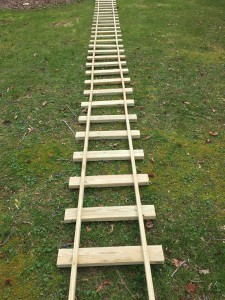Rails
Track construction can be divided into making the rails and making the cross-ties. The rails are made by ripping a 5/4″ decking board into three strips that are equal in width. Deckboard is used, as it is easy to work with, readily available, and comes pressure-treated.
Cutting the deckboard into strips leaves two rails that have the rounded edges, and a center strip that has square edges. I used a router with a quarter-inch rounding bit to round the edges of the center strip. This way, I can get three rails from one deckboard.
Cross Ties
The cross ties are made from pressure-treated 2x4s that are cut into two-foot lengths. To ensure that the rails keep the proper distance between them and are firmly anchored to the cross ties, I cut grooves into the cross ties to hold the rails. Since the 5/4″ deckboards are actually one inch in thickness, I needed grooves that were one inch wide and that were spaced the proper distance apart.
My first thought about cutting the groves was to put a dado blade on the table saw. But a little research showed that there are no dado blades for a ten-inch table saw that are one inch wide. This would have necessitated at least two passes per groove, and it would have been difficult to ensure that the groves maintained the proper widths and distances between each other.
My first attempt at actually cutting the grooves was to just make multiple passes over the table saw blade with each pass cutting just the width of the saw kerf. I made enough cross ties to construct an eight-foot section of straight track. But the process was labor-intensive and prone to error. Not a good solution for cutting hundreds of ties.
I abandoned the approach of using a table saw for cutting the grooves in favor of using a router. I found a router bit that cuts a one-inch wide groove with a single pass. This approach looked much more promising.

What I finally ended up doing was to attach several ties with bar clamps so I could cut all of them with a single pass of the router. I also cut a piece of plywood with a width such that it could be used as a router guide and ensure that the grooves for each side of the tie maintained the proper spacing. Here’s what the setup looked like:

Using this approach to making straight sections of rail, I constructed several sections and connected them so I could run an engine test. The test was just to make sure that the engine would track along the rails without jumping the tracks.